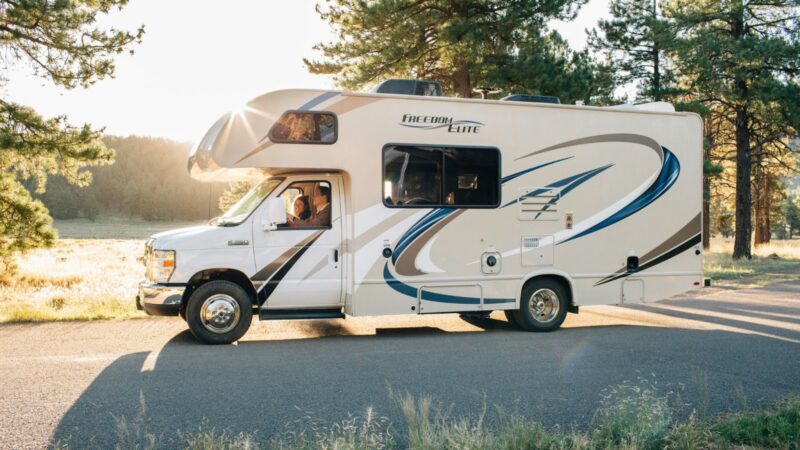Safe Travels: Handling Your Class C RV In The Wind
It’s that time of year. Bad weather is everywhere! If you find yourself at the wheel of a Class C RV in the wind, take a minute to pull over and review these tips for windy day driving safety.
Windy Day On The Road? Know How To Safely Drive Your Class C RV
Class C motorhomes are great. They allow you complete freedom as you wander the country. They tend to be smaller than their larger class A cousins—meaning they fit in more campsites—and some of the Class C rigs can accommodate as many as ten people. That said, Class Cs do have some drawbacks. One of the biggest cons becomes noticeable when driving a Class C in the wind.
The truth about Class C RVs is that they aren’t as aerodynamic as other types of campers. They are quite boxy, very top-heavy, and are essentially giant sails that catch every gust of wind. These big, heavy vehicles tend to steer quite differently than a traditional car, requiring more correction as you drive down the highway. These factors combined can lead to some seriously dangerous situations if you happen to be traveling in bad weather and wind.
Fortunately, there are ways to make driving a Class C in the wind a bit safer.
Check your tires
Tire pressure plays a surprisingly large role in how your motorhome drives. For this reason, you’ll want to check your tire pressure before each trip to ensure it is at the right level.
Keep in mind that the recommended pressure changes based on the weight of your rig. Therefore, you’ll need to get weighed on CAT scales and use your results to determine your tire pressure based on the charts provided by your tire manufacturer.
Balance your load
Another thing that can help keep your motorhome steady is making sure your load is balanced.
You can probably do a decent job of this by paying attention to where the heaviest items in your rig are and adjusting them to ensure the weight is relatively even from side to side, with a bit more weight in front of the front axles. The weights from the CAT scales can help with this, so review them to ensure everything is balanced properly.

Get an alignment
Poor wheel alignment can also lead to steering issues. It’s a good idea to take your motorhome to a reputable shop and get a four-wheel alignment before hitting the road. If you feel your RV wanders a lot, consider asking the shop to set the front wheels to the maximum toe-in setting (while still in spec) to give you more control.
Make some upgrades
If you’ve checked your tires, gotten an alignment, balanced your load, and still find that your Class C is hard to steer, tends to wander, or gets thrown off course easily, we highly recommend making some upgrades before your next trip.
- A Safe-T-Plus steering control bar can work wonders.
- Other beneficial upgrades include Hellwig anti-sway bars on the front and rear of the rig.
- Bilstein shocks, and SumoSprings can improve rear suspension.
Try one upgrade at a time. Start with the steering control bar, until you feel comfortable driving your rig in the wind.
Slow down
With all the above checked off your list, it’s time to hit the road and face the wind. Our first suggestion? Slow down.
55 mph is fast enough for any RV, and in high winds, you might even find yourself slowing to 50 mph to feel safe. It’s better to have control of your vehicle and arrive a little later than to lose control and never arrive at all.
Keep your distance
A sudden gust of wind can cause you to momentarily lose control. This can happen to any vehicle. Hence, it’s wise to keep your distance from other vehicles. If you see a car driving alongside you, consider changing lanes or slowing down to let them pass.
Watch the landscape
The landscape can change wind behavior. For instance, if you’re driving between two mountains and exit that sheltered area, you’re likely to face sudden gusts. If you’re driving against heavy winds, you might frequently adjust the steering wheel. Entering a protected area like under an overpass with your steering wheel turned can cause unintentional turns, potentially leading to accidents. Thus, pay close attention to the landscape and anticipate how it might affect your driving.
Give yourself a break
Driving against constant high winds and managing strong gusts is exhausting. This kind of driving demands more frequent stops than what you’d experience during calm weather. Take those breaks and rest. If possible, alternate driving duties with another adult. You shouldn’t be driving when fatigued, especially in challenging conditions.
Consider postponing
In some cases, it’s wiser to postpone your trip rather than driving a Class C in the wind. If you’re new to RVing and don’t feel comfortable driving in windy conditions, consider waiting for a better day. Even experienced drivers might want to delay travel in winds exceeding 50–60 mph, as Class C motorhomes can flip in such strong winds.
Hopefully, this guide helps boost your confidence when driving a Class C in the wind. By taking action on the preparatory steps mentioned, you can be better prepared for those windy days ahead!
Get RV-safe directions
Get all of your camping and trip planning needs in a one-stop-shop. RV LIFE Campgrounds and RV LIFE Trip Wizard. Campground Reviews is a peer-reviewed resource of campground and RV park reviews. With its accompanying RV LIFE App, RV Trip Wizard gets you to your camping destinations by planning RV-friendly routes customized to your RV and travel preferences.
The post Safe Travels: Handling Your Class C RV In The Wind appeared first on RV LIFE.






